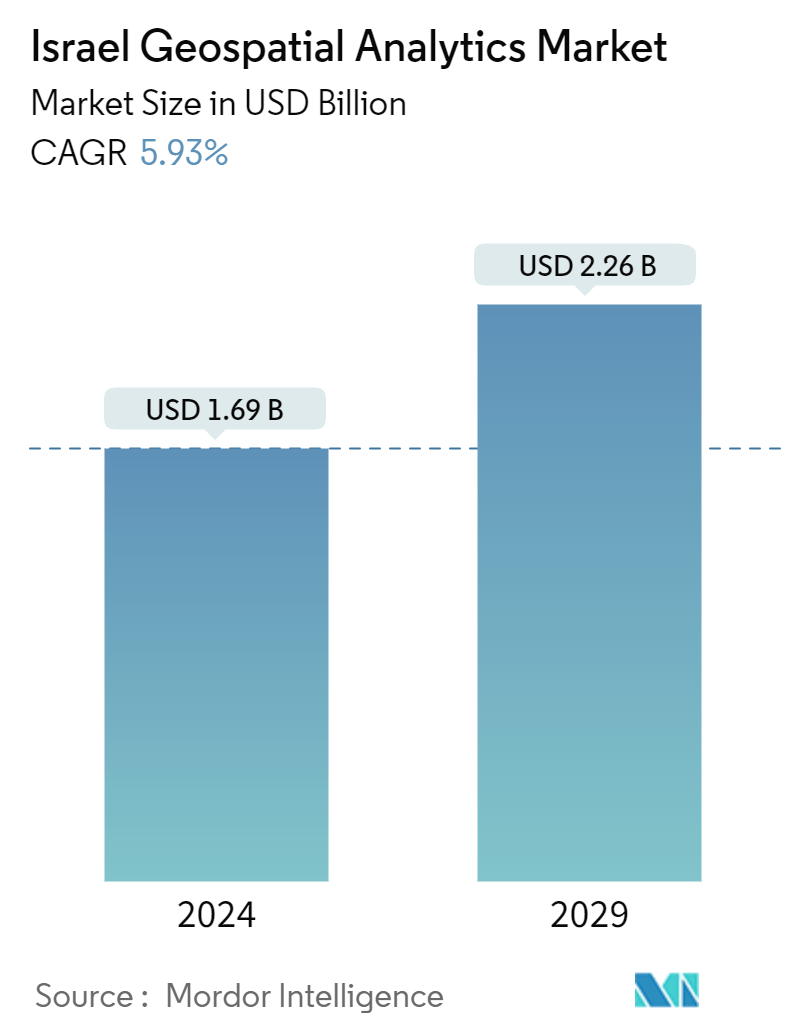Market Size of Israel Geospatial Analytics Industry

| Study Period | 2019 - 2029 |
| Base Year For Estimation | 2023 |
| Market Size (2024) | USD 1.69 Billion |
| Market Size (2029) | USD 2.26 Billion |
| CAGR (2024 - 2029) | 5.93 % |
| Market Concentration | Medium |
Major Players
*Disclaimer: Major Players sorted in no particular order |
Israel Geospatial Analytics Market Analysis
The Israel Geospatial Analytics Market size is estimated at USD 1.69 billion in 2024, and is expected to reach USD 2.26 billion by 2029, growing at a CAGR of 5.93% during the forecast period (2024-2029).
Geospatial analysis refers to a broad range of activities that emphasize applying various techniques to data comprising geographical or space-related characteristics. Some of the key factors driving the development of the geospatial analytics market include the increasing use of GPS devices, technological advances in the field of GIS technology, recent trends in integration and convergence of geospatial technologies, the advent of new corporation models aimed at leveraging the demand for geospatial information, and increased application of geospatial analytics in city and town planning.
- There is an increasing rate of urbanization, hence, to create self-sustaining cities where a diverse set of drivers, such as quality of life, economic development, energy faculty, mobility, governance, security, living conditions, free movement, and people, are in constant flux, geospatial technology is central to providing a technological platform that forms the backbone of a city. An infrastructure for power, security, water, transportation links, drainage, and sewage supports its residential and commercial spaces. With increased spending in smart cities, geospatial solutions are witnessing increased adoption in these projects.
- In June 2023, Israel's national roads company is undertaking a large-scale, multi-year project to digitize its entire network. Surveying company Kav Medida has been awarded the contract to map the northern half of the network using advanced GIS software, UAVs, and 360° mobile mapping cameras. The resulting digitized maps will significantly improve road maintenance and monitoring accuracy and efficiency in Israel, providing detailed measurements related to lighting pole arm lengths, sign heights, traffic sign azimuth, ditch type, and cross-section depths.
- Visualizing business objects on maps is crucial for improving efficiency and decision-making in various asset-intensive industries, like energy, transportation, and the public sectors. Geospatial analysis can help organizations streamline the processing of enterprise and spatial data for greater location awareness across business processes. Approximately 80% of the enterprises have location data (even in the form of addresses or zip codes). With geospatial analysis, they can locate their consumers on a map, see who is closest to them or their competitors, and where they should put their next location.
- Implementing a new technology brings new challenges that may involve privacy-related concerns, like GIS and other mapping technologies. There have been several instances where gathering geospatial data earned the wrath of regional privacy and demographics laws. Ideally, new technologies need to be embraced and integrated into the social discourse to enable end users to gain benefits.
- However, certain governmental agencies have been very cautious about the 'democratization' of data, specifically in the case of sensitive installations. Societal responses to privacy issues that have come up because of the integration of GIS and GPS have primarily been mixed. However, there has also been an overriding sense of optimism over the benefits of geospatial data.
Israel Geospatial Analytics Industry Segmentation
Geospatial analytics is the process of acquiring, manipulating, and displaying imagery and data from the geographic information system (GIS), such as satellite photos and GPS data. The specific identifiers of a street address and a zip code are used in geospatial data analytics. They are used to create geographic models and data visualizations for more accurate trends modeling and forecasting.
The Israel geospatial analytics market is segmented by type (surface analysis, network analysis, geovisualization), end user vertical (agriculture, utility and communication, defence and intelligence, government, mining and natural resources, automotive and transportation, healthcare, real estate, and construction). The market sizes and forecasts are provided in terms of value (USD) for all the above segments.
| By Type | |
| Surface Analysis | |
| Network Analysis | |
| Geovisualization |
| By End-user Vertical | |
| Agriculture | |
| Utility and Communication | |
| Defense and Intelligence | |
| Government | |
| Mining and Natural Resources | |
| Automotive and Transportation | |
| Healthcare | |
| Real Estate and Construction | |
| Other End-user Verticals |
Israel Geospatial Analytics Market Size Summary
The Israel geospatial analytics market is poised for significant growth, driven by the increasing integration of geospatial technologies in various sectors. This market encompasses a wide range of activities that apply geographical data to enhance decision-making and operational efficiency. Key factors propelling this market include the rising adoption of GPS devices, advancements in Geographic Information System (GIS) technology, and the convergence of geospatial technologies with other digital solutions. The growing urbanization and the development of smart cities in Israel further underscore the importance of geospatial analytics, as these technologies provide critical insights for urban planning, infrastructure development, and resource management. The market is also witnessing increased adoption in sectors such as energy, transportation, and public services, where geospatial data is used to optimize operations and improve service delivery.
The market landscape is moderately consolidated, with major players like Microsoft Corporation, Autodesk, Inc., and Esri, Inc. actively investing in strategic partnerships and product innovations to enhance their market presence. Recent developments include the introduction of new geospatial analysis functions by Microsoft and strategic collaborations between companies like Autodesk and Esri to integrate Building Information Modeling (BIM) with GIS data. These advancements enable stakeholders to visualize and analyze infrastructure within its real-world context, facilitating better planning and execution of projects. Additionally, the market faces challenges related to privacy concerns and regulatory compliance, particularly in the collection and use of geospatial data. However, the overall sentiment remains optimistic, as the benefits of geospatial analytics in enhancing operational efficiency and supporting smart city initiatives continue to drive market growth.
Israel Geospatial Analytics Market Size - Table of Contents
-
1. MARKET INSIGHTS
-
1.1 Market Overview
-
1.2 Industry Attractiveness - Porter's Five Forces Analysis
-
1.2.1 Bargaining Power of Buyers
-
1.2.2 Bargaining Power of Suppliers
-
1.2.3 Threat of New Entrants
-
1.2.4 Threat of Substitutes
-
1.2.5 Intensity of Competitive Rivalry
-
-
1.3 Industry Value Chain Analysis
-
1.4 Assessment of the Impact of COVID-19 on the Market
-
-
2. MARKET SEGMENTATION
-
2.1 By Type
-
2.1.1 Surface Analysis
-
2.1.2 Network Analysis
-
2.1.3 Geovisualization
-
-
2.2 By End-user Vertical
-
2.2.1 Agriculture
-
2.2.2 Utility and Communication
-
2.2.3 Defense and Intelligence
-
2.2.4 Government
-
2.2.5 Mining and Natural Resources
-
2.2.6 Automotive and Transportation
-
2.2.7 Healthcare
-
2.2.8 Real Estate and Construction
-
2.2.9 Other End-user Verticals
-
-
Israel Geospatial Analytics Market Size FAQs
How big is the Israel Geospatial Analytics Market?
The Israel Geospatial Analytics Market size is expected to reach USD 1.69 billion in 2024 and grow at a CAGR of 5.93% to reach USD 2.26 billion by 2029.
What is the current Israel Geospatial Analytics Market size?
In 2024, the Israel Geospatial Analytics Market size is expected to reach USD 1.69 billion.

